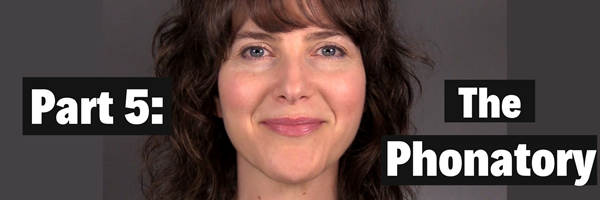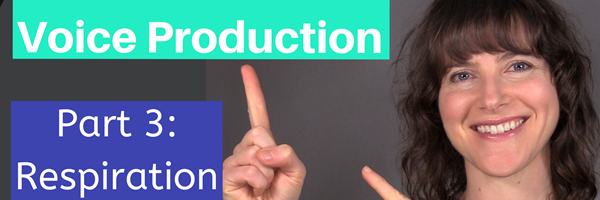(Video Transcript)
This video is part 4 of the Basics of Voice Production series. Make sure to watch the earlier videos that discuss how the voice is made, vocal warm ups, and exercises to improve your breath support for speaking.
Now let’s talk about specific exercises you can do to improve the next vocal subsystem - the Resonatory System.
The Resonatory System
The resonatory system provides the voice with its distinct quality, and it is why we all sound different from each other. The resonance system is made up of the open spaces within the throat, mouth, and nose, so you can think of this system as an open space.
The sound that is made at the vocal cords is only a buzzing sound, and we all sound very similar at this level - it’s sort of like a ppppppp sound. And as that ppppppp sound from the vocal cords bounces around in the open spaces of the resonance system, certain frequencies of the sound are amplified, and other frequencies are dampened, and the result is your unique sounding voice.
When you use your resonatory system to its fullest capability, your voice might sound more...rich...full... warm...pleasant. These are some adjectives that my clients have used to describe how a resonant voice sounds to them.
And once you know how to speak with a resonant voice, your voice should feel effortless, easy, and light. It’s a voice that is produced without any tension in the throat or mouth.
Resonatory System: Exercises
Now to the exercises. The best way to work out your resonance system is to hum. When you hum, you are making an MMMMMMM sound. The M sound is a nasal sound in American English, and we want to take advantage of that open space in the nasal passage in order to promote more resonance in the voice.
Exercise #1: Hum on a Comfortable Pitch
Start by humming on a comfortable pitch: MMMMMMMMM. I want you to put your fingers on the bridge of your nose to feel the vibration of your voice. MMMMMMMM. Do you feel it? This vibration is a good sign - the more vibration you can achieve, the better. You may also feel vibration along the lips or the front of the face. MMMMMMMM. So as you complete these exercises, remember: The vibration is good! Now put your fingers under your nostrils so you can feel the airflow - you should feel a steady stream of warm air coming out. MMMMMMMM.
Another tip: Make sure you relax your throat as you hum. If you tense up your throat, your hum will sound like this: MMMMMM, kind of strained, and you won’t have any vibration along the nose or mouth. You also will have very little airflow coming out of your nose. You want a relaxed throat and a buzzy sensation along your nose, lips, and face. MMMMM. And lots of airflow! MMMMM.
Exercises #2 - 4: Scales, High, Low
Now hum up and down a scale: MMMMMMMMMMM. Hum as low as you can go: MMMMMMMMMM. Then up as high as you can go: MMMMMMMMMM.
Do this 8 to 10 times, or more, depending on how long it takes for your voice to feel buzzy and relaxed.
After you’ve done a few scales on a hum, you might find that it is already easier for you to talk. Try it: Hum up and down a scale a few times, with a nice, resonant, easy voice. Feel the buzz along your nose, lips, and face, and make sure you have a good amount of airflow coming out of your nose. MMMMMMMM.
Now talk. Say, Hi my name is Julie. If you warmed up your resonance system correctly, you’ll probably feel that your voice is easy, light, rich, maybe even louder.
Exercise #5: Words with the M Sound
Now let’s take the hum one step further. Let’s use words that begin with an M sound, like moon, and hold out the MMM sound. Mmmmoon. Mmmmmooon. Try to have a buzzy vibration in the nose, lips and front of the face for the entire word - don’t let the sound travel to the back of your throat. Keep things forward.
Exercise #6: Longer words with the M and N Sounds
Now say, moonman, and hold out the M and the N sounds. Mmmmmoonnmmmmannnnn. Feel the buzz, keep the sound forward. Moonnnmmmmannnnn.
Exercise #7: Additional words and phrases with M and N
You can continue with this exercise using additional words and phrases that have lots of M and N sounds, and remember to hold out the M and N sounds until you feel a nice vibration along your nose, lips, and front of the face. Here are some examples:
Meet my mom.
Never nap at night.
Mice might make more money.
Meet me at the movies.
Nothing needs to go next.
Thanks for watching! Stay tuned for the next part of the Basics of Voice Production series: exercises to improve phonation! And I'd love to hear from you - contact me to learn how we can work together to perfect your American English pronunciation!



